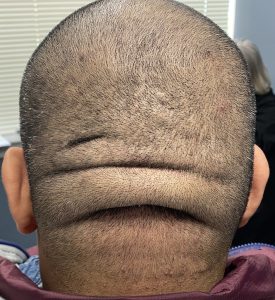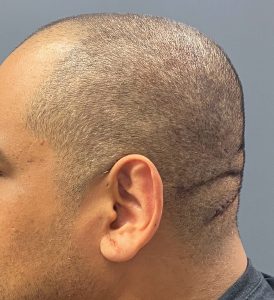Background: The back of the head is unique in many ways but is the only skull surface that can have bone and scalp aesthetic deformities. The back of the head can have bony protrusions such as occipital knobs and buns as well as a wide variety of bony flattening and asymmetry shapes. Excess scalp can also appear as rolls at the junction of the bottom of the occipital skull bone and the neck muscles. Such scalp rolls appear in a variety of involvement from single to even triple scalp roll deformities.
Usually you see back of the head bone and scalp deformities as separate aesthetic issues but rarely they can appear together. When it is a skull deficiency that requires a custom implant augmentation the first question is what incisional approach is needed for its placement and can the scalp roll excision site be used for it. (presumably and ideally yes) Then the question becomes what type of scalp roll excision is needed.
Scalp rolls are redundant soft tissue that appears as horizontal rolls with a indentation lines above or below. Usually the deepest indentation line is on its underside directly again the lower end of the occipital bone. (aka nuchal ridge) This indicates that the excess scalp roll is ‘hanging over’ the end of the bone. When a single scalp roll is present its partial or complete excision with a horizontal scar tradeoff is an obvious surgical solution. But when double and triple scalp rolls or very deep indentation above and below a single roll exist the surgical solution is not so straightforward.







Highlights:
- Scalp rolls on the back of the head can camouflage as bone deformities in profile.
- Scalp roll excision can be done as part of a back of the head reshaping with a custom skull implant.
- The custom skull implant can be inserted through the scalp roll excision but may need a small dissection/placement incision to guide the implant placement.
Dr. Barry Eppley
World-Renowned Plastic Surgeon







